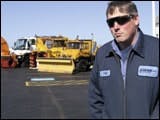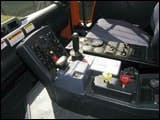Jeff Berls, equipment maintenance manager at DuPage County (Ill.) Airport, says his '78 and '89 Unimogs are "unstoppable machines." They're posed with a current U500.
It's almost out of its element on a paved parking lot, but here and on streets is where this U500 with sweeper body and brushes would work. Different tools with other purposes might take it far off road.
Maybe you saw it on the History Channel's Modern Marvels program. It's the Mercedes-Benz Unimog, a remarkable multi-functional, all-terrain truck, and the current model has been slowly catching since first coming to America three years ago, according to the sales and service team that's part of the Freightliner Group.
Surveys show that many potential buyers have heard of it but most don't know much about it, so slow but steady marketing efforts continue. That Modern Marvels episode first aired in August 2004, and "our phones start ringing every time it runs again," says Bob McTernan, director of Unimog of North America.
However, one question that comes up from municipal fleet people — prime potential customers, along with agencies and companies that can use the Unimog's versatility and off-road ability — is its transmission. It's semi-automatic or, as some see it, a semi-manual gearbox, because it requires constant use of the clutch and shift lever. It's easy to learn and easy to drive, but it's not an automatic.
To avoid driver training and drive-train problems, municipalities in the United States and Canada embraced Allison automatic transmissions many years ago. More recently, so did many private operators. And they wonder why they can't get something like the Allison in a Unimog. Now they can, almost.
It's called Electro Automatic Shift, or EAS, and it's what's generically known here as an automated mechanical transmission. It does the clutching and shifting while the driver merely punches the accelerator and steers. EAS has no torque converter or powershift functions, so is not a full automatic, but McTernan and his colleagues feel it's close enough, while still retaining the preciseness inherent in a manual.
EAS makes the Unimog even easier to drive and complements its do-anything, go-anywhere character. (Well, almost anywhere. But if you can't get there in a Unimog, you probably don't need to go.) During a demonstration at the DuPage County Airport outside Chicago, I drove a couple of Unimog 500s with EAS on streets and access roads. Alas, rough terrain wasn't part of the program.
First, a review of the U500, which we first covered in our September '03 issue. The original Unimog — the name is an acronym for Universal Motor Garact, or Tool — was born in post-World War II Germany as an agricultural tractor that could also take a farmer's goods to market. It since has grown in size and evolved into the multi-purpose military and civilian machine seen here; more than 360,000 units have been sold in 180 countries since production began in 1951, officials say.
The pictures make it look like a cute little cabover, but it's a full Class 7 truck meant to carry heavy power tools and mount a variety of work bodies. Its chassis sits high, so there's a brisk, three-step climb into its cab. Once there, the view is commanding and, once underway, there's a reassuring feeling of stability. Under the tilting composite-fiber cab is a Mercedes-Benz inline 6-cylinder diesel set for 260 horsepower. This is the same engine used in Freightliner and Sterling mid-range trucks, where it's called the MBE 906.
The U500's stout chassis includes four-wheel independent suspension with a long coil spring at each wheel. The all-wheel-drive system uses a single-speed transfer case, differential locks front and rear, and hub reduction gears. Low- and low-low gear sets for the transmission are optional, as are a mechanical power take-off and various hydraulic circuits that can run scores of implements.
A basic U500 starts at more than $100,000, but it can replace several trucks and pieces of equipment, from snow plows to lawn mowers. That's because implements can be quickly attached and detached and the truck and its operator kept busy all year round. Fewer vehicles in the fleet mean less total maintenance, insurance premiums and all the other costs of ownership, Unimog people say.
Specialty bodies can also be mounted and dismounted, and at the demo Unimog announced several new units, including a street sweeper, fire-fighting apparatus and a hooklift, which itself can handle several types of platform-based bodies. Also new is a VarioPower high-pressure hydraulic system that can run implements that now need auxiliary engines.
The DuPage County Airport owns two Unimogs, and the equipment maintenance manager, Jeff Berls, said they are rugged, reliable and long lived — "unstoppable machines," as he put it. The first one, a '78 U900, was bought to replace three trucks, but now is dedicated to snow removal; so is an '89 U1250. In 28 years, the U900 has required only fluid changes, a new clutch and some rebuilding of its hydraulic brake system. He'd gladly buy another 'Mog if the budget allowed it.
The old U900 has a three-lever manual transmission, so the new Electro Automatic Shift is a modern marvel. Like other such products, it uses electronically controlled clutching and shifting that the driver needn't be concerned with, except that he/she should know that a clutch is there to avoid abusing it. Indeed, with EAS the clutch can still be used manually, and should be while in the transmission's optional low-range modes. Otherwise, the clutch pedal folds up and out of the way, and the tranny becomes a two-pedal type.
The gearbox is the same Telligent eight-speed used in all U500s, and its standard "highway" ratios take the truck up to 70 mph. You choose Auto or Manual with a rocker switch near the paddle-like shift selector, both on a small console next to the driver's seat. In full manual mode, you move the selector to Drive, engage the clutch with the pedal, apply power, then upshift by tapping the paddle up and quickly punching the clutch. Downshifting is similar; you preselect the next lower gear by tapping the paddle backward and punch the clutch.
In Auto mode with the clutch pedal folded up, you simply switch to Drive and depress the accelerator. Usually it'll start out in 2nd or 3rd and upshift as the engine revs up. It will downshift as road speed falls, eventually going to one of the lower gears and declutching as the truck comes to a stop. There was some clunking as the transmission descended into its lower gears, but it never missed any. To move out, you take your foot off the brake pedal, which signals the controls that they can engage the clutch as soon as you again get on the accelerator.
If you use a very light foot, EAS will "short shift" — upshift at low rpm — but pressing the pedal to get moderate to snappy acceleration causes the engine to rev almost to its 2,600-rpm limit in each gear. I found this a little disconcerting because I was taught years ago that high revs waste fuel. Shift "progressively," keeping engine speed low until you really need the horsepower that comes at higher rpm, the old pros told me. And you really don't need a lot of horsepower until you're on the highway.
So I used EAS's semi-manual feature: I tapped the paddle selector to initiate an upshift, usually for each gear change. The clutch still works automatically, and I could watch the tachometer or just listen to the engine and command a shift whenever I thought it necessary, which was almost always below 2,000 rpm. I could floor the accelerator and still short shift, and could downshift while braking to get more engine drag. Or I could leave it alone and the automated shifting would proceed as the transmission's controls thought best.
As capable as the EAS is, it's not fully automatic and therefore might not fully answer the Allison question posed by some potential customers. But engineering an Allison RDS into a low-volume vehicle might not make much economic sense. So the automated variant of the manual 8-speed is the answer, and it's a clever one.









